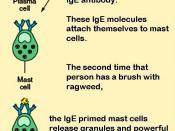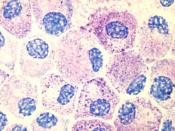The inflammatory response is triggered whenever body tissues are injured by physical trauma, intense heat, irritating chemicals, or infection and begins when a flood of inflammatory chemicals are released into the extracellular fluid. Macrophages bear surface membrane receptors called Toll-like receptors (TLRs) that play a central role in triggering immune response. Each TLR is recognized for a specific class of attacking microbe. Once activated, a TLR triggers a release of cytokines that promote inflammation and attract WBCs.
Injured and stressed tissue cells, phagocytes, lymphocytes, mast cells, and blood proteins are all sources of inflammatory mediators. The most important are histamines, kinins, prostaglandins, complement, and cytokines. Damaged connective tissue releases Cytokinins causing mast cells to release histamine. Basophils also respond to Cytokinins by secreting histamine. Histamine is a major signal for inflammation causing increased capillary permeability and increased vasodilation. Complement promotes the events of inflammation via classical and alternative pathways, which diverge to release C3a, causing a greater amount of histamine release and increased vascular permeability.
Another sequence of events that results in inflammation is the secretion of IgE by plasma cells in skin. It's stem region binds to mast cells and basophils and when it's receptor ends are triggered by an antigen it causes the cells to release histamine and other chemicals that mediate inflammation and an allergic reaction.
The inflammatory response prevents the spread of damaging events to nearby tissues, disposes of cell debris and pathogens, and sets the stage for repair so healing can occur quickly. The inflammatory response increases capillary permeability and diverts blood to the inflamed area to increase WBCs, platelets, antibodies, complement, RBCs, clotting proteins, oxygen, Cytokinins, and water, which is important in washing away and diluting toxins. Water also increases swelling which limits the flow of bacteria by increasing pressure. Redness and heat...


